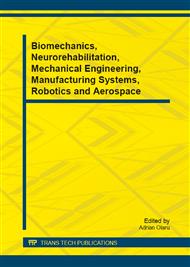[1]
P. Marcián, O. Konečný, L. Borák, J. Valášek, K. Řehák, D. Krpalek, Z. Florian, On the Level of Computational Models in Biomechanics Depending on Gained Data from Ct/Mri and Micro- Ct, Mendel Jou. ser. 17 (2011) 255-267.
Google Scholar
[2]
P. Marcián, Z. Majer, Z. Florian, I. Dlouhý, Stress Strain Analysis of High Porous Ceramics, Adv. Mat. Res. 482-484 (2012) 1330-1333.
DOI: 10.4028/www.scientific.net/amr.482-484.1330
Google Scholar
[3]
P. Marcián, Z. Majer, I. Dlouhý, Z. Florian, Estimation of Local Mechanical Properties of Highly Porous Ceramic Materials, Chem. pappers. In press (2012).
Google Scholar
[4]
V.J Kingsmill, Post-extraction remodelling of the adult mandible, Crit. Rev. in Oral Biol. & Med. 10 (1999) 384-404.
Google Scholar
[5]
L. Baggi, I. Cappelloni, M. Di Girolamo, F. Maceri, G. Vairo, The influence of implant diameter and length on stress distribution of osseointegrated implants related to crestal bone geometry: a three-dimensional finite element analysis. J Prosthet Dent. 100 (2008) 422-431.
DOI: 10.1016/s0022-3913(08)60259-0
Google Scholar
[6]
A. Mellal, H. W. Wiskott, J. Botsis,S. S. Scherrer, U. C. Belser, Stimulating effect of implant loading on surrounding bone. Comparison of three numerical models and validation by in vivo data. Clin. Oral. Impl. Res. 15 (2004) 239-248.
DOI: 10.1111/j.1600-0501.2004.01000.x
Google Scholar
[7]
O. L. Koca, G. Eskitascioglu, A. Usumez, Three-dimensional finite-element analysis of functional stresses in different bone locations produced by implants placed in the maxillary posterior region of the sinus floor. J. Pros. Dent. 93 (2005) 38-44.
DOI: 10.1016/j.prosdent.2004.10.001
Google Scholar
[8]
C. S. Petrie, J. L. Williams, Comparative evaluation of implant designs: influence of diameter, length, and taper on strains in the alveolar crest. A three-dimensional finite-element analysis. Clin. Oral Implants Res. 16 (2005) 486-494.
DOI: 10.1111/j.1600-0501.2005.01132.x
Google Scholar
[9]
D. Bozkaya, S. Muftu, A. Muftu, Evaluation of load transfer characteristics of five different implants in compact bone at different load levels by finite elements analysis. J Prosthet. Dent. 92 (2004) 523-530.
DOI: 10.1016/j.prosdent.2004.07.024
Google Scholar
[10]
H. Van Oosterwyck, J. Duyck, J. Vander Sloten, G. Van der Perre, M. De Cooman, S. Lievens, The influence of bone mechanical properties and implant fixation upon bone loading around oral implants. Clin. Oral. Implants. Res. 9 (1998) 407-18.
DOI: 10.1034/j.1600-0501.1996.090606.x
Google Scholar
[11]
A.N. Natali, R.T. Hart, P.G. Pavan, I. Knets, Mechanics of bone tissue, in: A.N. Natali (Ed.), Dental Biomechanics, Taylor & Francis, London, 2003, p.1–19.
DOI: 10.1201/9780203514849.ch1
Google Scholar
[12]
Ch. Clason, A.M. Hinz, H. Schieferstein, A method for material parameter determinative for the human mandible based on simulation and experiment. Com. Meth. in Biomech. and Biom. Eng. 7 (2004) 265-276.
DOI: 10.1080/10255840412331313590
Google Scholar
[13]
S. Futterling, R. Klein, W. Strasser, W., Weber, H., Automated finite element modelling of human mandible with dental implants, 6-th International Conference in Central Europe on Computer Graphics and Visualization. (1998).
Google Scholar
[14]
C. H. Turner, H., J. Rho, J., Y. Takano, T. Y. Tsui, G. M. Pharr, The elastic properties of trabecular and cortical bone tissues are similar: results from two microscopic measurement techniques. J. Biomech. 32 (1999) 437–441.
DOI: 10.1016/s0021-9290(98)00177-8
Google Scholar
[15]
T. Albrektsson, P. I. Brånemark, H. A. Hannsson, J. Lindström, Osseointegrated titanium implants. Requirements for ensuring a long-lasting direct bone anchorage in man, Acta Ortho. Scan. 52 (1981) 155-170.
DOI: 10.3109/17453678108991776
Google Scholar
[16]
H. Sekine, Y. Komiyama, H. Hotta, K. Yoshida, Mobility characteristics and tactile sensitivity of osseointegrated fixture-supporting systems. Tissue integ. in oral maxilla. rec. (1986) 326–332.
Google Scholar
[17]
C. Mish, Contemporary Implant Dentistry, Mosby Elsevier, Indiana University, 2008.
Google Scholar


